Game Overview
Master of Orion II: Battle at Antares (MOO II) is a turn-based space strategy game. What does that mean? Well, if you know Civilization, then think of the same thing but with the cities being planets and the units being spaceships.
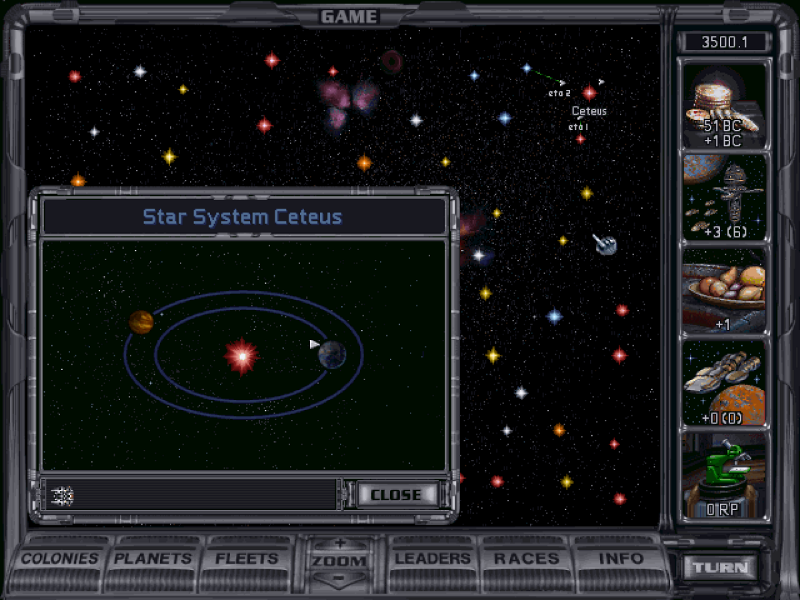
At the beginning of a game you control a single planet, two scout ships and a colony ship. All around the star system you start in are other systems. About one to five of those will be in range of your spaceships. You send out your scoutships and look for a good planet in range to found a colony. In time you will explore more space and colonise further planets. You will research new technologies, enabling you to build installations on your planets that improve their production capacity, enabling you to build better, faster, deadlier spaceships.
Those will soon become necessary, because you are not alone. After a few dozen turns you will probably make first contact with another species. Depending on the personality of its ruler you might be able to make friends and cooperate in the realms of trade and science, resulting in greater profits and faster scientific advance. Or perhaps it will be hate at first sight. Of course you don't have to play nice either. You can build some warships and incinerate the enemy fleets, bombard their planets or invade them.
Eventually you will make contact with more alien species, up to seven of them, depending on the way you set up the game.
How do you win? There are three possible ways to do that. The most obvious one is to eliminate all other players. The second possibility is to get yourself elected as ruler of the galaxy. This requires either a good deal of sweet-talking or, alternatively, you can simply have two-thirds of the total galactic population in your empire.
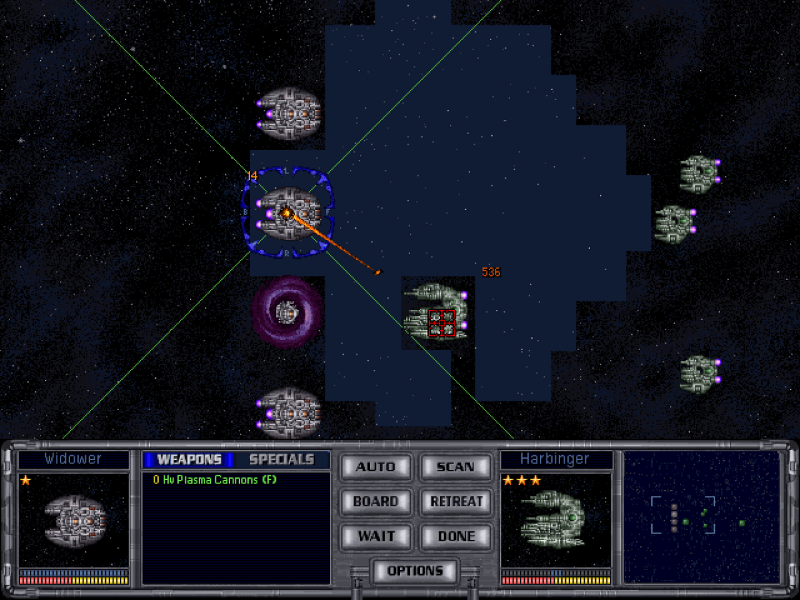
The third path to victory is only available if you chose the option "Antaran Attacks" in the game setup. If you did, then the Antarans, hyperagressive monsters, will pop out of some other dimension every once in a while and attack a planet. Just pray it isn't yours: the Antarans have extremely advanced technology and defending against them can be very difficult. Thus the third way to win: take the fight to them and attack their homeworld. To do this you will need to construct a dimensional portal, a piece of technology that has to be discovered first. You will also need a massive high-tech fleet to stand any chance at all of defeating them.
One way of getting the technology necessary to destroy the Antarans (or eliminate the other species) is to destroy the Guardian protecting the Orion system in the center of the galaxy. The Guardian is equipped with technology of similar potency as that of the Antarans, but it's only one ship. Also, unlike attacking the Antarans, who have a number of nasty tricks up their sleeves, it's a very straightforward fight. Once you have destroyed the Guardian you will receive some highly advanced military technology.
You can play this game on a variety of difficulty levels, galaxy sizes, galaxy compositions (choose between a galaxy filled with easily habitable but poor planets or one filled with lifeless, precious rocks) and number of opponents.
Features
Some other features of MOO II that have so far gone unmentioned:
- You can have up to four Administrators who can be assigned to a star system each. They will increase food production, industrial output or the scientific capabilities of all planets in that system, or offer other advantages. A great variety of Administrators with various capabilities are available for hire.
- Your spaceships' capabilities can be boosted by up to four Commanders. Similar to the Administrators, they improve the speed, damage, accuracy or evasion capabilities of the ship they are assigned to.
- The ability to design your own spaceships, meaning that you can choose what kind of weaponry and special systems should be carried by your ships. One of the most interesting features of MOO II, it will be described in greater detail later.
- The ability to design the species you play. While there are thirteen standard species available, you can also custom-build one, choosing the appearance of one of the thirteen standard species. This, too, is so interesting that it is described in detail later on.
- A variety of multiplayer options for playing over a local network, over the Internet or on a single computer. ("Hotseat" multiplayer, where you take turns at sitting in front of the same computer. Does not work very well, but it's better than nothing.)
Managing your Empire
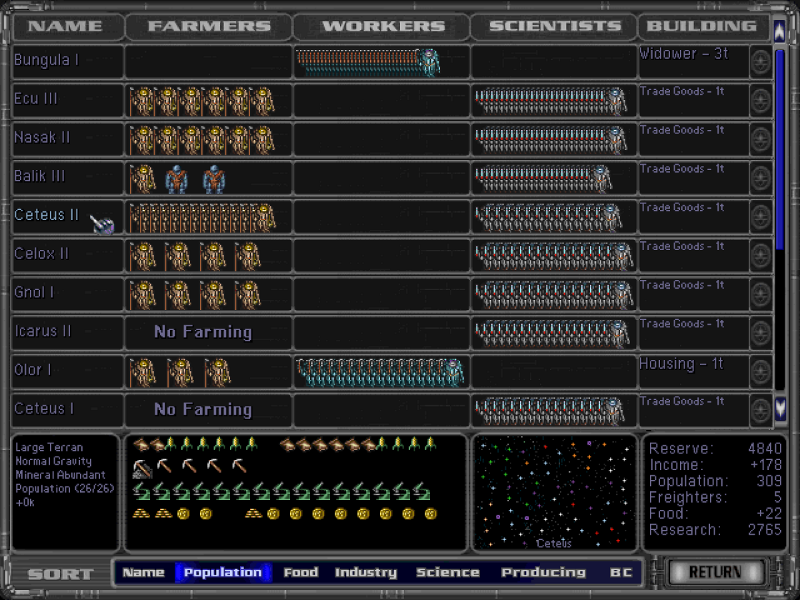
Anybody who has ever played a 4X game (like Civilization) knows that managing your empire in the later stages of the game becomes very tedious. While that is a problem with MOO II as well, it does have some nice features that cut down on the time you need to spend on mundane tasks. The planets have a build queue, meaning that you can make a list of items that should be built on that planet instead of having to give it new orders every time it's finished with one item. The colonies screen is also a great help, as it gives you all relevant information about all of your colonies, allowing you to move around people to different tasks and different planets, and to quickly see what your planets are producing.
Designing your Species
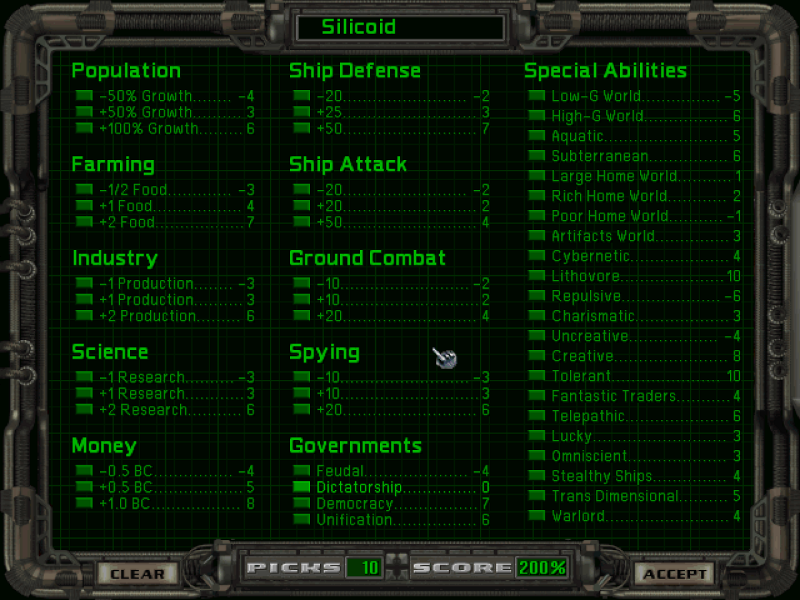
You can choose from a variety of advantages and disadvantages for your species. You have a total of ten points that you can use for advantageous choices, which cost anything from one to ten points. Disadvantageous choices give you more points to spend, up to an additional ten.
You can increase or decrease the population growth rate, the food production, industrial output, scientific output and tax money gained per population. You can also choose to tweak your species' ability to hit enemies accurately in space combat, evade said enemies or fight against them in invasions. A bonus or malus to your aptitude for espionage can also be chosen.
An important choice is the choice of government. There are four options available: Dictatorship, which is the standard setting, Unification (Hive Mind), Democracy, and a Feudal system which is so bad for research that you get bonus choice points.
In addition to those options you can select from a variety of other effects. For example you can make your species live underground, which results in an increase in the maximum population on your planets. Or the expensive but highly practical "Lithovore" option which eliminates the need for food production. Not all of those options are so useful: the "Lucky" ability, costing three points, is mostly useless and so is the "Transdimensional" ability.
With designing species, production capability and general ability to expand quickly is crucial. A low-tech expansionist species will always win over a small high-tech scientific species, due to sheer weight of numbers.
Any text about MOO II longer than a few hundred words inevitably contains the favourite species design of the author. This is mine:
- Lithovore (no need to produce food, due to rocks = food)
- Subterranean (more space on planets, due to living underground)
- +1 Industrial Production
- -10% Espionage
- -10% Ground Combat (both easily compensated by technology or numbers)
- Feudal Government (horrible research but cheap ships, including colony ships)
I have since somewhat changed my opinion on that, but that's for another, incredibly geeky post.
This species can colonise planets that other species would never consider. Since the main limit to expansion is the availability of suitable planets, these creatures can expand more rapidly than anybody else. The increased industrial production and Feudal government greatly cut down on the time required to build colony ships. The main disadvantage of these creatures is the very bad research capability, but that can be compensated by comparatively gigantic populations.
Designing your Spaceships
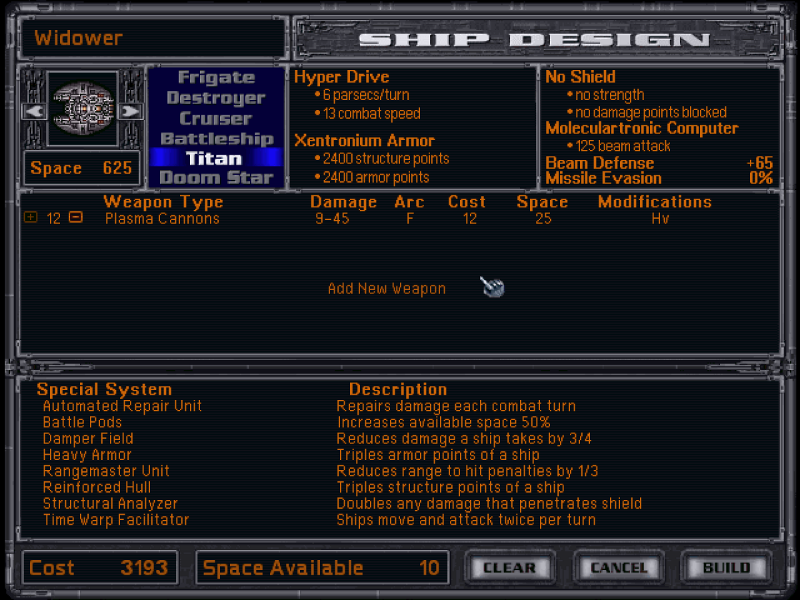
The first step is designing a spaceship type is deciding the size of the vessel. There are five available sizes: Frigate, Destroyer, Cruiser, Battleship, Titan and Doom Star.
You can choose from a great variety of special systems (which have to be researched first), for example the Rangemaster Unit which improves beam weapon damage over long ranges, or an ECM Jammer for defending against missiles.
The various weapons available can be roughly split into the following categories:
- Beam Weapons, which hit instantly but typically lose effectiveness over range.
- Missiles, which do a lot of damage but can be shot down or jammed.
- Torpedoes, basically missiles that can't be stopped but require lots of space and fire only every other turn.
- Space Fighters
- Bombs for use against planets.
The various weapons often have special abilities, like the Neutron Blaster which kills off the crew of the ship it hits, thus making it easy to take it over by boarding it. Special weapons include the Tractor Beam, used to immobilise ships so they can be boarded, or the Stasis Field, which puts an enemy ship out of play until it is deactivated.
Probably the coolest weapon of them all is the Stellar Converter, a huge highest-tech plasma gun which can be used to blow up enemy planets.
Good spaceship design is important. As mentioned in a writeup above, your fleet does not have to be versatile. That is true insofar that you certainly shouldn't copy the computer's way of designing ships, which consists of putting every conceivable kind of weapon into its ships, resulting in a versatile but very ineffective vessel.
There are several ways of creating a good warship:
One way is by simply filling it with lots of high-yield missiles that can all be fired within the first two turns. The damage such a ship causes is immense, enabling you to quickly destroy the enemy before he has any chance to do significant damage. The problem with this strategy is that if you don't win within two turns then you're dead. This design can be used with the smallest and the largest of ships, but it is rather ineffective later in the game, since missiles can be shot down, jammed or evaded.
A more advanced strategy is designing a ship which is very hard to hit. There are numerous upgrades and special systems that can be used to increase the "beam defense" and "missile evasion" values of the ship, enabling it to evade most enemy attacks. Keep your distance from the enemy or they will hit you nevertheless. Cruisers and Battleships strike a good balance between speed and size for this design.
Once you have researched potent armor and automatic repair systems you can make heavily armored ships that depend upon their repair systems to repair most if not all damage caused in a combat turn. This works well with titan-size ships or doom stars.
Flaws and Oddities
While MOO II is a great game it is riddled with balance issues and absurd limitations:
- Some weapons are far more potent than others.
- Starfighters are essentially useless.
- You can only have four administrators/commanders. Actually, this is quite a reasonable design decision.
- Espionage doesn't work very well against the computer.
- There is no private chat in multiplayer.
- The AI is totally incompetent at ship design.
- On higher difficulty levels you will constantly get framed (blamed for acts of espionage you did not commit) and will so be pulled into war with everybody else.
- There is no way you can choose the weaponry and general design of your star bases, which makes them rather ineffective. (So you sometimes get to use Ion Cannons against Antarans, who are totally unhurt by them!)
- Synchronising Game Data over a network takes an eternity. (You have to do this at the beginning of every network game.) I doubt this is still the case in 2013, but I haven't had the opportunity to try.
Make sure to play the game on the newest patch version (1.6 for Macintosh, 1.31 for Windows) 1.40b23, these days to avoid the worst of the balance problems.
Far worse than those annoyances are two little oversights, which, when exploited, make combat ridiculously easy.
The first problem is with the Stasis Field: It is possible to do the following: Freeze the enemy in a Stasis Field on the very first turn. Then, on the next turn, deactivate the field, fire at it, and then reactivate the field, leaving it frozen once again. This way, the enemy ship always spends its own combat turns frozen and unable to act. This makes the Guardian very easy to defeat once you have researched the field.
The worse problem is with a combination of two special ship systems: the Time Warp Facilitator and the Phasing Cloak. These are both very high-level technologies, but once you have researched them you can use them the following way: The Time Warp Facilitator gives your ship an extra combat turn every turn. The Phasing Cloak makes your ship impossible to hit while active, but your ship cannot fire while cloaked. In order to activate the cloak the ship must spend one turn without firing. Now, that is what happens if you combine the two: On the first combat turn you uncloak your ship and fire at the enemy. On the second combat turn (provided by the TWF), do not fire and allow your ship to cloak again. Now it's the enemy's turn but he cannot hit you. Rinse and repeat. The result: a totally indestructible warship.
When playing against other people over a network, there is usually an agreement not to use those two tricks.
Availability
You can still get copies of MOO II as far as I know. It's available for PC and Macintosh. I would suggest you have a look at it. Although it is very old, the graphics do not hurt your eyes. And despite its flaws, the gameplay is so good that I still occasionally play it. You can get it from GOG.com for $7 at time of writing.
The sequel, Master of Orion III, has been released recently, but I haven't yet gotten my hands on it because the Macintosh version is still in the making. chortle sob MOO III was... less than good, and pretty much managed to kill off the series. Might do a writeup on that at some point. Anyway, go play MOO II - there's nothing quite like it.